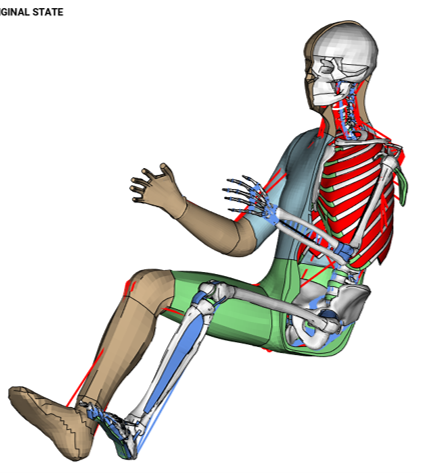The SAFER Human Body Model is going global to save more lives in traffic
The cluster of SAFER Human Body Model projects has provided the partners with world leading human body model functionality, used by the industry in safety developments to save lives and prevent injures in traffic. The model has also contributed to position SAFER’s multi-disciplinary research excellence internationally. This area is not only a role model for excellent and cross-border research, it is also a role model for how the collaboration within the SAFER community can achieve more than just single project execution.
The research results are moving towards providing an open-available model globally, to enable wider use of the tool. In the new FFI-project; Global SAFER HBM, the model will take steps towards the global arena.
The purpose of the project is to make SAFER HBM a biofidelic, robust, competent, and attractive tool for the project partners’ needs, also including being available to the community. Specific goals include to further improve the model, with special attention on spinal kinematics and injury risk prediction, and to enable global use of the model by preparing it for being open available. The SAFER HBM will have capabilities to model the combined pre‐crash and in‐crash occupant in‐crash response including muscle activation, which is crucial for instance for prediction of cervical spine injuries.
The purpose of the project is to make SAFER HBM a biofidelic, robust, competent, and attractive tool for the project partners’ needs, also including being available to the community. Specific goals include to further improve the model, with special attention on spinal kinematics and injury risk prediction, and to enable global use of the model by preparing it for being open available. The SAFER HBM will have capabilities to model the combined pre‐crash and in‐crash occupant in‐crash response including muscle activation, which is crucial for instance for prediction of cervical spine injuries.
Our family of human body models has contributed significantly to SAFER’s excellent research results and to our partners' product development over the years. The cluster of projects has helped to speed up the process of industrial implementation significantly, providing the SAFER partners with a state-of-the art human body model.
A short overview of the work packages in the Global SAFER HBM:
Work Package 1 – Data for Spinal Curvature
In the first work package, the researchers will establish spinal curvature for seated female and male occupants in modern passenger car seats. The following sub-tasks are included:
- Define methods to be used to define spinal alignment and pelvis orientation for occupants traveling in a modern car seat.
- Carry out a volunteer study in which the spinal curvatures and orientation of the pelvis of seated occupants are recorded in a modern car seat.
- Submission of an ethical application for the volunteer study.
Work Package 2 – Model Development and Integration
The project team will also integrate and further develop the SAFER HBM body parts to improve the model and remove third party IP.
Work Package 3 – Model Validation
The following subtasks regarding model validation are included:
- Validation acceptance criteria
- Passive model validation frontal to side impact load cases
- Passive model validation in rear-end impacts
- Active model exploration frontal to side impacts load cases
- Active model exploration rear-end impacts
Work Package 4 – Spine Injury Prediction
Identifying cervical spine injury mechanisms and tissues to focus, including implementation in other FE models are the key activities in the fourth work package: Research will for example include a feasibility study of using previously developed lumbar spine fracture prediction criteria for thoracic spine and to identify future tasks within area.
Work Package 5 - Utilization
With the overall purpose to make the SAFER HBM an efficient, robust and attractive tool, ready for being open available, this work package encompasses the activities to quality check, document and develop proof-points to demonstrate its capabilities. These activities are structured in the following sub-tasks:
- Performance specification
- Quality routines
- Validation database
- Demonstrators
- SAFER HBM model certified for Euro NCAP VT
- Free-Access framework
- Benchmark with respect to crash test dummies in high severity rear-end impacts
The project partners are Autoliv Development, Chalmers University of Technology, Sahlgrenska University Hospital and Volvo Cars. The project will be lead by Jonas Östh, Volvo Cars, and the research will be funded by the FFI Safe Automated Driving programme. The total budget is 8,686 kSEK. The project starts 2022-11-01 and end 2024-12-31.
About the SAFER HBM
SAFER’s HBM vision encompasses a scalable, tuneable, human body model with omni-directional injury prediction capabilities, suitable for use in high-g and low-g events and as any road user, occupant or vulnerable group. This means a virtual human substitute that can be used for predicting injury outcome in any impact situation and direction of loading, able to be morphed to replicate a large proportion of the population, standing or sitting, with humanlike kinematics in crash events as well as pre-crash manoeuvres.

